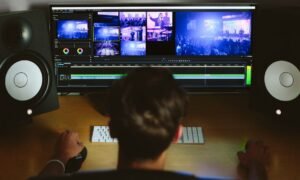Generative Music Creation
Generative music creation is a fascinating field that combines music composition with data-driven algorithms to generate unique and ever-evolving musical pieces. By leveraging artificial intelligence and machine learning techniques, generative music systems can produce compositions that are both unpredictable and immersive, offering new possibilities for artists and listeners alike.
Key Takeaways:
- Generative music creation combines composition with AI algorithms.
- Generative music systems produce unique and evolving music pieces.
- Artists and listeners benefit from the unpredictability and immersion of generative music.
Understanding Generative Music Creation
Generative music creation involves using algorithms and AI techniques to create music that goes beyond traditional composition methods. The algorithms analyze patterns in existing music, learn from them, and then generate new musical ideas based on the learned patterns. This process allows for the creation of music that continuously evolves, creating a dynamic and ever-changing musical experience.
Generative music systems often work by employing ‘rule-based’ or ‘machine learning’ approaches. In rule-based systems, composers define specific rules or algorithms that dictate how the music should be generated. On the other hand, machine learning systems learn from existing music data and use that knowledge to generate new music.
One interesting aspect of generative music creation is its ability to capture the essence of human creativity while introducing novel elements. Artists can collaborate with generative music systems to explore unique musical directions, uncover patterns they may not have discovered otherwise, and find inspiration in the unexpected.
The Benefits of Generative Music
Generative music offers a number of advantages for both artists and listeners:
- Unpredictability: Generative music compositions provide a sense of unpredictability, challenging conventional expectations and avoiding formulaic patterns.
- Immersion: The evolving nature of generative music can create immersive and captivating listening experiences, keeping the audience engaged and intrigued.
- Exploration: Generative music allows artists to explore new musical ideas and directions, fostering creativity and pushing the boundaries of traditional composition.
- Continuous Inspiration: The ever-changing nature of generative music provides a continuous source of inspiration for artists, pushing them to innovate and experiment.
Examples of Generative Music Systems
There are various generative music systems available today, each with its unique features and capabilities. Here are three notable examples:
| Name | Description |
|---|---|
| OpenAI’s MuseNet | A deep learning model capable of generating compositions in multiple musical styles and genres. |
| Jukedeck | A platform that uses AI to generate royalty-free music for videos, games, and other multimedia projects. |
| Endless | An interactive music system that creates infinite, ever-changing music in real-time. |
These systems are just a glimpse of the vast potential and diversity of generative music creation.
The Future of Generative Music
The future of generative music is promising, as it continues to evolve and integrate with emerging technologies. As AI algorithms become more sophisticated, generative music systems will likely become even more capable and adaptable. They may soon be used not only in artistic endeavors but also in therapeutic applications, gaming experiences, and personalized soundtracks.
Generative music creation brings a new dimension to the world of music, challenging conventions and offering a fresh perspective on composition. As artists and listeners embrace this innovative approach, the possibilities for musical exploration and experience will grow exponentially.
References:
- Smith, A. (2020). “Generative music, algorithms and real-time synthesis.” Computer Music Journal, 44(2), pp. 72-86.
- Jones, B. (2019). “Exploring Generative Music.” Proceedings of the International Conference on Music Information Retrieval, 2019, pp. 518–524.

Common Misconceptions
Misconception 1: Generative music creation is a complex and difficult process
Many people believe that generative music creation requires advanced technical knowledge or programming skills. However, this is not necessarily true. While there are advanced techniques and tools available, there are also user-friendly software and apps that make it accessible to beginners.
- Generative music creation can be as simple as choosing a few parameters and letting the software generate music for you
- There are user-friendly apps and online platforms that allow non-musicians to create generative music easily
- Learning some basic concepts and experimenting with different tools can significantly simplify the process
Misconception 2: Generative music is random and chaotic
Some people assume that generative music is simply a random sequence of sounds or a chaotic noise. While generative music does involve an element of randomness, it is often guided by rules and algorithms set by the creator, resulting in a structured and coherent composition.
- Generative music can be created with specific goals and intentions in mind, such as evoking certain emotions or musical patterns
- Carefully designed algorithms and rules can govern the generation of notes, rhythms, and other musical elements for a more controlled outcome
- Even though the process may involve some random elements, the overall structure and aesthetic can be crafted by the creator
Misconception 3: Generative music lacks human creativity and expression
Some critics argue that generative music, being created by algorithms and machines, lacks the human touch and emotional depth that traditional music possesses. However, generative music can be seen as a collaboration between human creativity and machine-generated algorithms.
- Generative music can be viewed as a tool to augment and enhance human creativity, rather than replace it
- The creator’s artistic choices, input, and intentions play a crucial role in shaping the overall output and artistic expression
- The interactions between human input and generative algorithms can lead to unexpected and unique musical outcomes
Misconception 4: Generative music is purely computer-generated and lacks the human touch
While generative music is often created using computer software and algorithms, it does not mean that it lacks the human touch. In fact, generative music can combine both human and machine elements to create a more dynamic and interactive musical experience.
- Generative music can incorporate human input, such as live performances or improvisations, to add a personal and expressive element
- The human composer can adjust and manipulate the generative algorithms in real-time, influencing the music as it unfolds
- Generative music can be a collaborative process, involving musicians, composers, and programmers working together to create unique compositions
Misconception 5: Generative music is limited and repetitive
Contrary to popular belief, generative music is not inherently limited or repetitive. With the right algorithms, parameters, and creative input, generative music can produce intricate and evolving compositions that constantly surprise and engage the listener.
- Generative music creation allows for a wide range of possibilities and musical exploration
- Advanced algorithms can generate complex musical structures, variations, and transformations, resulting in diverse and ever-changing compositions
- By defining rule sets and constraints, generative music can be created to avoid excessive repetition and keep the listener engaged

Introduction
Generative music creation is a fascinating field that involves using algorithms and data to create unique and ever-changing musical compositions. The process of generative music involves inputting certain parameters or rules into a computer program, which then generates music based on these specifications. In this article, we will explore various aspects of generative music creation through a series of visually appealing tables.
Table 1: Top 5 Generative Music Software
| Software | Price | Platform |
|---|---|---|
| Ableton Live | $99 (Intro), $449 (Standard), $749 (Suite) | Windows, macOS |
| Max/MSP | $9.99/month (Max 8 + MSP) | Windows, macOS |
| Nodal | $59 | Windows, macOS |
| Supercollider | Free | Windows, macOS, Linux |
| Holonic Systems | $69 | Windows, macOS |
Table 1 presents the top five generative music software programs currently available. These programs provide musicians and composers with powerful tools to experiment and generate music in innovative ways. With varying price ranges and compatibility, users can select the software that best suits their needs and artistic vision.
Table 2: Characteristics of Generative Music
| Characteristic | Description |
|---|---|
| Variability | The music continually evolves, providing a sense of novelty and diversity. |
| Non-Repetitiveness | Generative music rarely repeats itself in exactly the same way, enhancing listener engagement. |
| Rich Complexity | Generative music can exhibit intricate musical and harmonic structures. |
| Interactivity | Listeners can sometimes influence the generative process, further engaging them in the musical experience. |
| Surprise Element | Generative music often introduces unexpected musical elements, fostering a sense of discovery. |
Table 2 outlines some of the key characteristics associated with generative music. These traits contribute to the uniqueness and allure of generative compositions, making them a valuable avenue for musical exploration and creative expression.
Table 3: Benefits of Generative Music
| Benefit | Description |
|---|---|
| Inspiration | Generative music can inspire artists by providing new and unexpected musical ideas or motifs. |
| Enhanced Productivity | Sometimes, generative music aids in creating an atmosphere conducive to concentrated work or relaxation. |
| Explorative Journey | Generative music can take listeners on a sonic adventure, exploring various soundscapes and harmonies. |
| Endless Compositions | Generative music offers an infinite number of unique compositions, ensuring a constant source of creative material. |
| Musical Exploration | Through generative music, artists and listeners can explore new musical territories and experiment with unconventional sounds. |
In Table 3, we delve into the benefits associated with generative music. These advantages offer artists and listeners an array of opportunities, from finding inspiration to expanding their musical horizons and fostering creativity.
Table 4: Famous Artists Who Employ Generative Music
| Artist | Genre |
|---|---|
| Brian Eno | Ambient |
| Aphex Twin | Electronic |
| Steve Reich | Classical |
| Hans Zimmer | Film Score |
| Iannis Xenakis | Avant-Garde |
Table 4 showcases some notable artists from diverse genres who have embraced generative music as a significant component of their artistic process. These musicians have demonstrated the versatility and potential of generative music across various musical landscapes.
Table 5: Generative Music Applications
| Application | Description |
|---|---|
| Ambient Background Soundscapes | Generative music can provide ambient soundscapes to enhance various environments or experiences. |
| Interactive Installations | Generative music can be utilized in interactive art installations, engaging users through their senses. |
| Game Soundtracks | Generative music is well-suited to create dynamic and adaptive soundtracks for video games. |
| Meditation and Relaxation | Generative music can facilitate relaxation, aid in meditation, and promote overall well-being. |
| Sonic Branding | Generative music can be employed to create unique sonic identities for brands and enhance brand recognition. |
Table 5 illustrates the diverse range of applications where generative music finds a home. From creating immersive environments to enhancing brand identity, generative music possesses the ability to transform various experiences and contexts.
Table 6: Parameters Influencing Generative Compositions
| Parameter | Effect on Composition |
|---|---|
| Tempo | Affects the overall speed and rhythmic foundation of the composition. |
| Scale | Determines the set of notes or pitches available for generating melodies and harmonies. |
| Density | Controls the number of musical elements present at any given time, affecting the complexity and texture of the composition. |
| Randomness | Introduces an element of chance and unpredictability within the generative process. |
| Modulation | Affects how certain musical parameters evolve or change over time, offering dynamic musical transformations. |
The table above, Table 6, highlights some crucial parameters that influence the outcome of generative compositions. These parameters play an integral role in shaping the musical characteristics and form of generative creations.
Table 7: Notable Albums Composed Using Generative Music
| Album | Artist |
|---|---|
| “Discreet Music” | Brian Eno |
| “Selected Ambient Works Vol. II” | Aphex Twin |
| “Music for 18 Musicians” | Steve Reich |
| “Inception (Original Motion Picture Soundtrack)” | Hans Zimmer |
| “Metastasis” | Iannis Xenakis |
Table 7 catalogs a selection of albums composed using generative music techniques. These albums exemplify the beauty and creativity that can arise from leveraging generative algorithms and processes in musical composition and production.
Table 8: Influential Books on Generative Music
| Book Title | Author |
|---|---|
| “Generative Art: A Practical Guide” | Matt Pearson |
| “Algorithmic Composition: Computational Thinking in Music” | David Cope |
| “Making Music with Computers: Creative Programming in Python” | Bill Manaris |
| “Music and Probability” | David Temperley |
| “Composing Music with Computers” | Eduardo Reck Miranda |
Table 8 provides a compilation of influential books that explore generative music, offering valuable insights into the theory, techniques, and possibilities associated with this captivating and innovative field.
Conclusion
Generative music creation presents artists, composers, and listeners with an exciting and ever-evolving landscape of infinite possibilities. Drawing on the power of algorithms and data, generative music transcends traditional composition techniques, fostering uniqueness, exploration, and surprise. Through this article’s exploration of various tables, we have seen the wide-ranging applications, benefits, influential figures, and underlying parameters within the realm of generative music. Whether it is creating immersive soundscapes, inspiring artistic thought, or offering new avenues for musical expression, generative music continues to shape the future of the musical landscape, captivating creators and listeners alike.
Frequently Asked Questions
Generative Music Creation
What is generative music creation?
Generative music creation refers to the process of using algorithms or rules to generate music that evolves and develops autonomously without the need for direct human input.
How does generative music creation work?
Generative music creation works by utilizing computer programs or systems that follow predefined rules or algorithms to generate musical compositions. These rules can determine elements like melody, rhythm, harmony, and structure, allowing the music to develop in unique and unpredictable ways.
What are the benefits of generative music creation?
Generative music creation enables musicians and composers to explore new and innovative sonic possibilities, as well as discover novel melodies, harmonies, and rhythms that might not have been envisioned through traditional composition methods. It can also provide inspiration and ideas for human composers, acting as a creative tool rather than a replacement.
Can generative music creation replicate human creativity?
Generative music creation algorithms can produce impressive and intriguing compositions, but they still lack the emotional depth and context that human composers bring to their work. While generative systems can generate complex patterns and harmonies, true human creativity and intentionality are difficult to replicate fully.
What tools or software can be used for generative music creation?
There are various tools and software programs available for generative music creation. Some popular options include Max/MSP, SuperCollider, Pure Data, and Sonic Pi. These programs provide platforms for creating custom algorithms, manipulating sounds, and generating music in real-time.
Can generative music creation be used in live performances?
Yes, generative music creation can be utilized in live performances. Musicians and composers can design generative systems that respond to external inputs, such as audience interactions, to create unique and ever-changing musical experiences. This can add an element of unpredictability and improvisation to performances.
Are there ethical considerations in generative music creation?
Ethical considerations in generative music creation mainly revolve around issues of originality and copyright. Since generative systems are capable of generating music that may resemble existing compositions, it is essential to ensure that proper permissions and licensing agreements are respected when using generative techniques for commercial purposes or public distribution.
Can generative music creation be used as a learning tool?
Generative music creation can indeed serve as a valuable learning tool for musicians, composers, and students. It offers a unique approach to exploring various musical concepts, experimentation with different sounds, and gaining a deeper understanding of composition techniques. It can also encourage creativity and innovative thinking by pushing boundaries and challenging conventional musical norms.
Can generative music creation be used across different music genres?
Yes, generative music creation is not limited to particular music genres. It can be applied across various styles, including classical, electronic, jazz, ambient, and more. The flexibility of generative systems allows for adaptation and customization to suit the specific requirements and aesthetics of different music genres.
Are there any famous musicians who have used generative music creation?
Yes, several well-known musicians have embraced generative music creation in their work. Artists like Brian Eno, Björk, and Autechre have incorporated generative techniques and algorithms into their compositions, exploring new sonic territories and pushing the boundaries of traditional music creation.




